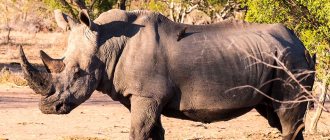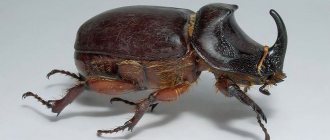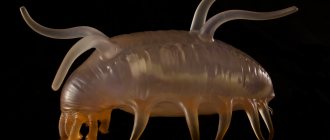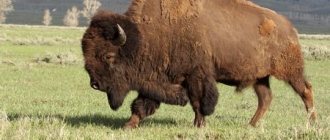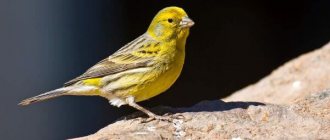- Wild animals
- >>
- Mammals
These large animals have been known to us since childhood as typical inhabitants of Africa. The white rhinoceros is recognizable by its protrusion on the front of its head, actually on its nose. This feature is where its name comes from. Because of its unusual nature, rhinoceros horns were mistakenly attributed in ancient times to have medicinal properties that actually do not exist. But because of this legend, many of the animals still suffer from poachers. Because of this, rhinoceroses can now be found mainly only in nature reserves or in national parks.
Origin of the species and description
Photo: White Rhino
The entire rhinoceros family in the modern classification is divided into two subfamilies and 61 genera, of which 57 are extinct. Moreover, their extinction occurred tens of millions of years ago, and therefore has nothing to do with human activity. The four living genera form five species, which separated from each other about 10-20 million years ago. The closest relatives are tapirs, horses and zebras.
The largest representative of rhinoceroses is the white rhinoceros, which has the largest number among them. The name has nothing to do with the color, and most likely comes from the Boer word wijde, literally meaning “wide”, which was too consonant with the English word white. The actual observed color of a rhinoceros depends on the color of the soil on which it walks, since the animal loves to wallow in the mud.
Video: White Rhino
The main distinguishing feature that distinguishes all rhinoceroses from other animals is the presence of a horn. The white rhinoceros has two. The first, the longest, grows on the nasal bone. Its length can reach one and a half meters. The second one is slightly smaller, located on the frontal part of the head. But at the same time, the forehead on the animal’s head is not so pronounced.
Despite its hardness, the horn does not consist of bone tissue or horny substance (like the horns of artiodactyls), but of a dense protein - keratin. This same protein is found in small quantities in human hair, nails, and porcupine quills. The horn develops from the epidermis of the skin. If damaged at a young age, the horn can grow back. In adults, the damaged horn does not recover.
The body of the rhinoceros is massive, the legs are three-toed, short, but very thick. At the end of each finger there is a small hoof. Because of this, rhinoceros foot prints are easily recognizable. Externally, its footprint is similar to a clover, since the animal rests on all three fingers when walking. In terms of size, the white rhinoceros ranks fourth among land animals, yielding the first three places to representatives of elephants.
Appearance and features
Photo: Animal white rhinoceros
A distinctive feature of the white rhinoceros is its wide (usually at least 20 cm) and fairly flat upper lip. For example, in a black rhinoceros this lip is slightly pointed and not so pronounced. There are no incisors on the upper jaw, so the lip partially replaces them. The canines are completely reduced.
The animal itself is quite massive. The weight of an adult individual can reach four tons or more. The height at the shoulders or withers is usually from one and a half to two meters. The length of the white rhinoceros ranges from two and a half to four meters. The neck is very wide, but short. The head is massive and large, slightly rectangular in shape. The back is concave. Sometimes you can see some kind of hump on it, which is a fold of skin. The belly is saggy.
Rhino skin is very dense and durable. The thickness of the skin in some places can reach one and a half centimeters. There is practically no hair on the skin. Only around the ears there is stubble, and the tail ends in a tuft of dense hair. The ears themselves are quite long, and the animal is able to move them and rotate them in different directions. The animal's hearing is sensitive, but it plays a secondary role. The white rhinoceros's vision is also not the best - it is nearsighted, so it usually relies on its sense of smell.
Fun fact: Rhinos have poor memories. Many zoologists believe that this is directly related to poor vision compared to other animals.
The lifespan of rhinoceroses is quite long, about 35–40 years in the wild, and even longer in captivity.
Interesting facts about the animal
Rhinoceroses have poorly developed vision, but their hearing and sense of smell are heightened. Therefore, they divide the territory using manure. It also helps them navigate the area better.
- Life expectancy is 50-60 years.
- Before mating, rhinoceroses may fight with each other.
- The thickness of the skin of a white rhinoceros can reach 8 cm.
Still have questions or have something to add? Then write to us about it in the comments, this will make the material more useful, complete and accurate.
Where does the white rhinoceros live?
Photo: Northern white rhinoceros
In the wild, white rhinoceroses live exclusively in Africa. Until recently, the habitat of the white rhinoceros was divided into two isolated parts - northern and southern, and the areas were isolated from each other and quite remote.
The southern part is located in the countries of Southern Africa:
- SOUTH AFRICA;
- Mozambique;
- Namibia;
- Zimbabwe;
- southeastern part of Angola.
The northern range was previously located in the Congo, Kenya and South Sudan. In 2022, the last of the males belonging to the northern subspecies died. Today, there are only two females left alive, so it can actually be considered that the northern white rhinoceros has been exterminated. In the southern part, everything is much better, and there are still quite a lot of animals there.
The white rhinoceros inhabits mainly dry savannas, but is also found in small wooded areas, with clearings in which low-growing grass grows. Prefers mostly flat terrain. White rhinoceroses are well adapted to the dry continental climate. They tolerate desert areas, although they try not to enter such areas. It is believed that a mandatory condition for a rhinoceros to live is the presence of a nearby body of water.
On hot days, rhinoceroses like to spend a long time in the water or take mud baths, and less often hide in the shade of trees. Therefore, sometimes white rhinoceroses are found near swamps. And much earlier they were even found in coastal areas. During times of drought, white rhinoceroses are capable of making long journeys over considerable distances. They do not like enclosed areas. Like other savannah residents, space is important.
Their survival depends on assisted reproduction techniques
After Sudan's death, scientists collected viable eggs from both Najin and Fatu, fertilizing them with frozen sperm from two male northern rhinos before they passed, in hopes of using a southern white rhino surrogate. Artificial insemination has already proven effective in southern white rhinos, and with only 0.1% genetic difference between the two subspecies, hope remains high that the southern subspecies could be the key to saving the northern white rhino. ()
What does the white rhinoceros eat?
Photo: African white rhinoceros
The rhinoceros is a herbivore. Despite its threatening appearance and not entirely calm character, it feeds exclusively on vegetation and pasture. Living in the savannah, it is not always possible to find a sufficient amount of succulent vegetation, so the digestive system of these animals is adapted to absolutely any type of plant.
It can be:
- twigs of bushes or trees;
- all kinds of herbs;
- low growing leaves;
- thorny bushes;
- aquatic vegetation;
- roots and tree bark.
They have to absorb food quite quickly. Every day, in order to get enough, they have to eat about 50 kg of various vegetation.
Rhinos eat in the morning and late in the evening. They are afraid of overheating in the hot sun, so they spend the day in puddles, ponds, mud or the shade of trees. Rhinos are large animals and need to drink large amounts of water daily. For this purpose, they are able to overcome enormous distances of several tens of kilometers. Usually they try to carve out a territory with a pond, where they will go every day to drink.
In general, rhinoceroses have roads along which they move every day, either to eat, to drink, or to rest in the mud or shade. The thick skin of rhinoceroses allows them not only to consume thorny plants, which are always present in abundance, because no other animal claims them, but also to live and calmly move around these same plants, being so clumsy.
Also, the white rhinoceros can use its horn and break interfering tree branches. If there is not enough food on its territory, then it goes to explore other spaces for food and may leave its territory.
Features of character and lifestyle
Photo: White rhinoceroses
At first glance, the rhinoceros may seem slow and clumsy due to its size, but if necessary, it can accelerate quite quickly and run some distance at a speed of about 40 km/h. Of course, he won’t be able to maintain high speed for a long time, but it looks very intimidating.
Rhinoceroses spend their days alone in their territories, which they choose once and for all their lives. Only very rarely can it happen that a lack of food will force a rhinoceros to look for new lands.
It is also very rare that rhinoceroses can unite in small groups, usually a species of white rhinoceros, but mostly live alone. The mother, having taught the cubs the basic things of life, drives him out of her territory and again remains alone.
The rhinoceros is primarily a nocturnal animal. They can devour vegetation all night long and sleep in the mud or pond during the day. Some species prefer to be active both during the day and at night. Although rhinoceroses have very thick skin, it can also dry out and burn in the sun, and they are also tormented by insects.
Rhinoceroses are helped to fight insects by birds that literally settle on their backs. These are wolves and buffalo starlings. They not only feed on insects and ticks from the back of the animal, but can also indicate danger. According to some reports, insects from the back of a rhinoceros are eaten not only by birds, but also by turtles, who are just waiting for the rhinoceros to sit in their puddle.
In general, rhinoceroses coexist peacefully with all other species of animals: zebras, giraffes, elephants, antelopes, buffaloes and even predators that are of little interest to adult rhinoceros. For this reason, rhinoceroses sleep very soundly and do not think about danger at all. At this moment, you can easily sneak up on them and remain unnoticed.
Interesting fact: If a rhinoceros senses danger, it will most likely rush to attack first. Therefore, this animal is dangerous for humans. Moreover, the most dangerous thing is a female with a cub - she will be very aggressive precisely because she will protect her baby with all her might.
Social structure and reproduction
Photo: White rhinoceros calf
Rhinoceroses are absolutely not social animals. They live alone, both males and females. They only get close during the mating season. For some time, females live with their cubs, but then they drive them away, and they also learn to survive on their own.
Male rhinos physiologically reach sexual maturity at approximately seven years of age. But they are not able to have sexual contact with a female right away - first they need to take possession of their own territories. One male rhinoceros owns a territory of about 50 square kilometers, and sometimes even more. The female has a much smaller territory - only 10–15 square kilometers.
Rhinoceroses mark their territories by leaving their own excrement on it and trampling down vegetation in certain places. Sometimes they tear small holes with their feet. Within their own territory, rhinoceroses trample down trails, some major and some secondary. Typically, the main trails connect feeding areas with places of bedding and shade during sunny hours. Rhinoceroses prefer not to trample down the remaining territory in order to preserve as much pasture as possible.
The mating season can occur at any time of the year, but in the spring there is often increased attention to the opposite sex in these animals. Although they have a rut every month and a half. Females and males seem to chase each other, thus showing interest. Sometimes they can get into a fight or a game, and it is impossible to fully understand what is happening between them. A female can drive away a male she doesn’t like, and only the most stubborn and persistent ones get the opportunity to fertilize her and pass on their genes to their offspring.
The gestation period lasts 460 days, then only one calf is born weighing from 25 to 60 kg. After a few hours, he walks independently and explores the world without leaving his mother. The lactation period lasts up to a year, although the small rhinoceros begins to eat vegetation from the third month. After the mother stops feeding her baby milk, it still remains with her for another year or year and a half.
Interesting fact: The female is capable of giving birth every 4-6 years. If she has a new baby, she drives away the older one and gives all her attention and care to the newborn.
What happens to severed horns?
Some reserves preserve cut horns - their special warehouses can store thousands of horns. The reserves are trying to get the ban on international trade in horns lifted so they can sell them and use the money for development. They suggest legal sales would be a blow to the black market.
Scientists from Oxford University came up with another option - they made an artificial rhinoceros horn from horse hair. They are convinced that selling a huge number of fakes will reduce the value of horns on the black market and hit poachers.
However, not everyone agrees that selling artificial horns or horns from nature reserves is the right decision. Many fear that this, on the contrary, will lead to an expansion of their sales market.
Some rhino safety activists call for the horns to be burned to show that they have no value. The first demonstrative burning of horns was carried out at the zoo in Dvur Kralove in the Czech Republic in 2014. Proponents of this method are convinced that legalizing the sale of horns in the world will only increase the danger to rhinoceroses.
Natural enemies of white rhinoceroses
Photo: White Rhino
White rhinoceroses have no clear enemies among the animals living side by side with them. Rhinoceroses are very large animals for predators. Therefore, if they dare to attack, then in almost 100% of cases they themselves die as a result of fights. However, as with other animal species, predators can pose some danger to white rhino cubs, for the simple reason that they can easily cope with small individuals.
It also happens that a rhinoceros enters into battle with an elephant. In this case, the rhinoceros is defeated more often, especially if the elephant manages to wound it with its tusks. Conflicts between these two animals rarely arise and are more often due to mutual misunderstanding, but such cases are quite well known.
Crocodiles can also attack rhinoceroses; they cannot cope with large individuals, but the cubs are easily dragged to the bottom, which they sometimes take advantage of.
The most terrible enemy of the rhinoceros was and is man. Since its discovery, the white rhinoceros species has been almost completely exterminated. The only thing that saved them was that not all regions at that time were accessible to humans. Now, despite the protection of white rhinos at the legislative level, animals are still killed for poaching purposes.
What attracts poachers
Horns are the most striking feature of the appearance of rhinoceroses and the source of their troubles. It is because of their horns that animals become victims of poachers.
Horns are in great demand in China and the countries of Southeast Asia. In traditional Chinese medicine, rhinoceros horn is believed to have healing properties. Powdered horn is used against fever, infections, blood purification, gout and arthritis. However, the anti-inflammatory effects of crushed rhino horn have not been scientifically proven.
In Western media you can read that traditional Chinese medicine allegedly uses horns as an aphrodisiac or hangover cure. But this is not true, although such myths play into the hands of poachers.
The cost of the horn on the Asian black market reached 60 thousand dollars per kilogram - more expensive than gold, cocaine and diamonds. The weight of one horn is from 1 to 3 kg, depending on the type of rhinoceros.
In 1977, the international trade in rhino horns was banned, but the extermination of the animals continued. For example, by the early 1990s, the number of black rhinoceroses had declined by almost 95 percent.
Population and species status
Photo: Animal white rhinoceros
Today, the only subspecies of white rhinoceros is the southern white rhinoceros. This subspecies has a status of near vulnerable. In the late 1800s, the subspecies was considered extinct, just over thirty years after its discovery. But soon white rhinoceroses were again discovered in remote areas inaccessible to humans in the Umfolozi River valley (in South Africa). In 1897, they were taken under protection, which ultimately led to a gradual restoration of the population. This made it possible, among other things, to place rhinoceroses in many national parks, and even transport individual individuals to zoos in Europe and America. Very slow population growth is associated with too long a breeding season.
Now the species is not in danger of extinction. Moreover, hunting of white rhinoceroses is even allowed, although it is subject to strict quotas. Due to quotas, a production license is quite expensive - almost 15 thousand dollars, and sometimes even more. Hunting is permitted only in South Africa and Namibia, and in both countries a special export permit is required to export trophies.
The total number of white rhinoceroses, according to some sources, is just over ten thousand individuals; according to other data, often cited in various media, their population can reach twenty thousand animals.
Poachers vs Rangers
To catch rhinos, poachers use equipment supplied by international criminal groups. The animal is shot with a tranquilizer gun, after which the horn is cut off with a saw, and the rhinoceros, bleeding, dies in agony. Rhinos are also subjected to traps, rat poison and electric shock.
Rangers fight poachers: they patrol the territories of parks and reserves. In some countries, such as Botswana, the law allows them to shoot to kill poachers, but neighboring countries view the law with skepticism - sometimes civilians die in shootouts between rangers and poachers.

